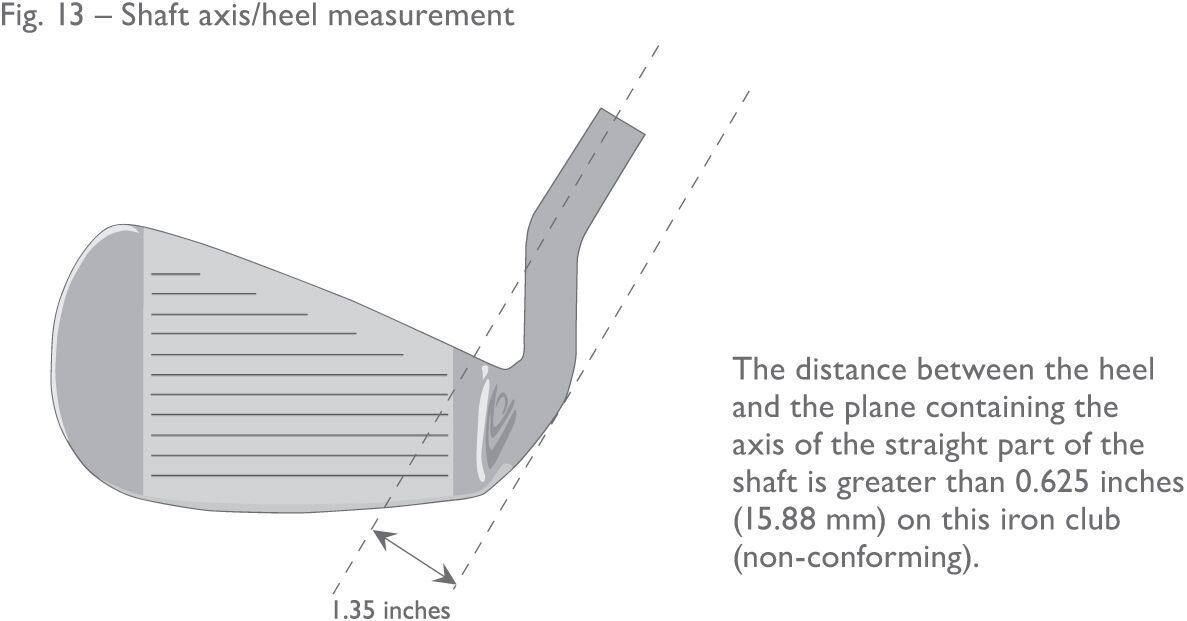1. Clubs
a. General
Interpretation of Rule 1.a
1.a(1) - Design
The terms “wood” and “iron” refer to the general shape of the clubhead. A wood club
is one where the head is relatively broad from face to back, and it can be made of
a variety of materials. An iron club is one where the head is relatively narrow from
face to back, and it is usually made of steel. While it can be challenging to distinguish
between these two club types because of the popularity of “hybrid”, rescue and utility
clubs, the determination of whether a club is a “wood” or an “iron” and, in turn,
which Equipment Rules apply to it is dealt with based on an overall assessment of
the shape and size of the head.
By definition, the loft of a putter must not be greater than 10 degrees. Putters are
permitted to have negative loft. However, a negative loft exceeding a magnitude of
15 degrees would not be considered “traditional and customary in form and make”.
The Equipment Rules rarely distinguish between wood and iron clubs (see Section 4b,
Dimensions, Volume and Moment of Inertia, for the main example of different treatment),
but there are various instances throughout the Equipment Rules where certain specifications
do not apply to putters or exceptions may be made for putters. These differences will
be highlighted at the appropriate places throughout the Equipment Rules.
Probably as a consequence of these differences, confusion often exists as to which
Equipment Rules apply to “chippers”. A “chipper” is an iron club designed primarily
for use off the putting green, generally with a loft greater than ten degrees. As
most players adopt a “putting stroke” when using a chipper, there can be a tendency
to design the club as if it was a putter. To eliminate confusion, the Equipment Rules
which apply to chippers include:
-
The shaft must be attached to the clubhead at the heel (Section 2c);
-
The grip must be circular in cross-section (Section 3b(i)) and only one grip is permitted
(Section 3c);
-
The clubhead must be generally plain in shape (Section 4a) and have only one striking
face (Section 4d); and,
-
The face of the club must conform to the specifications with respect to hardness,
surface roughness, material, markings in the impact area and dynamic properties (Sections
4c and 5).
-
The length of the club must follow the guidelines for chippers specified in the table
located in Section 1c.
1.a(2) - Traditional and Customary Form and Make
The phrase “traditional and customary form and make” does not mean that clubs must
look the same as they did 100 years ago. If so, for example, steel shafts and metal-headed
woods would not conform.
The “traditional and customary” clause is used when there is not a specific provision
that can be applied to a specific, non-traditional club feature, and/or the overall
club design deviates from traditional appearance and/or construction standards. For
clubheads, the “Plain in Shape” provision generally applies (see Section 4a, below).
1.a(3) - Club Composition
This clause means that a club is not permitted to have multiple shafts or heads. It
also highlights that it is not essential for a club to have material added to the
shaft to form a grip. For further information on a club which has no material added
to form a grip, see Section 3.
1.a(4) - All Parts must be Fixed
This clause means that no part of the golf club should be designed to move, nor should
it be promoted as doing so. Once assembled, all parts of the club which are bonded
must be bonded such that they require heat to loosen (see Section 1b below for clubs
which are designed to be adjustable). If any part of a club were to incorporate moving
powder, pellets, liquid, vibrating wires, rollers, tuning forks, or any number of
other features which could be considered a “moving part”, the club would not conform.
1.a(5) - External Attachments
While this clause prohibits the attachment of anything to the club which could potentially
have an effect on its performance (e.g. aiming bars or weights), other items may be
permitted to be attached to certain parts of the club provided (a) no performance
benefit can be derived, and (b) no other Equipment Rules are breached, as well as
Rule 4.3 of the Rules of Golf (Use of Equipment).
Examples of attachments that could be permitted include:
-
Temporary, non-permanent attachments to the shaft such as decals for identification
- such attachments, for identification only, may also be permitted on the clubhead
(other than the face). Additionally, tape to protect the shaft is permitted. However,
these attachments must not be usable for any other purpose (e.g. alignment).
-
Temporary, non-permanent attachments to the shaft (e.g. “clip-on” devices), provided
such items do not excessively protrude from the shaft, their cross-section conforms
to the shape of the shaft and they are sufficiently fixed. Other “clip-on” devices
that do not conform to the shape of the shaft (e.g. a club “prop” for use in wet weather)
may be attached to the shaft between shots but must be removed prior to making a stroke.
-
Other material added to the shaft, such as for alignment purposes, provided it is
considered semi-permanent. However, such applications must not breach Rule 4.3. “Semi-permanent”
is interpreted to mean durable and not easily removable. Additionally, it must not
be re-usable and/or must be essentially destroyed upon removal.
-
Temporary, non-permanent attachments to the butt end of the grip such as tee pegs,
ball markers or ball retrieving devices, provided:
-
such items do not cause the grip to be considered moulded for the hands or create
a bulge or waist in the grip; and
-
the outer diameter of the item is less than or equal to the outer diameter of the
butt end of the grip and the item does not extend beyond the butt end of the grip
by more than 2 inches (50.8mm).
-
Other temporary, non-permanent attachments to any part of the grip other than the
butt end, provided such items are removed prior to making a stroke. However, tape
or gauze applied to the full length of the grip is permitted provided the grip conforms
in its modified state and the underlying grip conforms.
-
Attachments to the clubhead (other than the face), such as protective coverings, decorative
items or alignment aids, provided the item is semi-permanent. However, such items
must not excessively protrude from the clubhead and must conform to the shape of the
clubhead. Also, for driving clubs, such attachments must not serve to cause any confusion
with the correct identification of a club on the list of Conforming Driver Heads.
Such attachments should, therefore, be subtle, plain in appearance and discreetly
positioned. Permanent additions to a clubhead would be considered part of the head
and, therefore, the head, in its modified state, would have to conform to Part 2,
Section 4 of the Equipment Rules (i.e. for dimensions and “plain in shape”).
The two long-standing permissible “external attachments” are (a) the permission to
use lead tape on the shaft or the head for weighting, and (b) the use of a suction
cup at the end of the grip of a putter to assist with retrieving the ball from the
hole. While lead tape can affect the performance of the club and a rubber suction
cup would exceed the diameter of the butt end of the grip, the use of both of these
items continue to be permitted on a traditional basis (but see Section 4b(i) below
for details on the use of lead tape on driver heads with a high Moment of Inertia).
b. Adjustability
Interpretation of Rule 1.b
1.b(1) - General
All clubs may be designed to be adjustable for many different characteristics – for
example, weight, length, lie and loft. In order to preserve the integrity of Rule
4.1a(3) of the Rules of Golf (“Deliberately” Changing Club’s Performance Characteristics
During Round), the Equipment Rules clearly state that it must not be too easy for
a player to make adjustments during a round and that the mechanism must be firmly
fixed, with little chance of it working loose. All adjustment mechanisms must comply
with the following requirements:
• Method of Adjustment
Adjustments must require the use of a special tool, such as an Allen key, a Phillips
screwdriver or a custom made device. It must not be possible to make the adjustment
just by using the fingers or some other object which would normally be kept in a golfer’s
pocket, for example a coin or a pitch-mark repair tool.
• Unusable Unless Locked or Fully Tightened
If, as is often the case, a screw is used to fix the mechanism, the club must, for
all practicable purposes, be unusable without the screw being in place and tightly
fixed. One exception to this “unusable” requirement is for a long putter with a shaft
which dismantles into two shorter lengths for travel purposes. Here, a screw together
(“pool cue”) joint is permitted, in combination with an Allen key screw, or similar,
which penetrates the threaded section of the joint by at least half way. The existence
of both the threaded joint and the fixing screw potentially renders the putter usable,
even when the screw is not tightened, or it is left out entirely. It also renders
the putter potentially adjustable by hand. However, this exception was introduced
as a specific concession for travel clubs
• Friction Fit Mechanisms
Generally, friction fit adjustment mechanisms are not permitted because there is potential
for them to be readily adjustable (i.e. the mechanism could be sufficiently tightened
such that the club is usable, but not quite enough to prohibit it from being adjustable
by hand). However, a friction fit mechanism which can be only locked and unlocked
and is fixed in its locked state and unusable in its unlocked state, may be permitted
upon evaluation.
• Discrete Steps
A mechanism that allows for an adjustment to be made in discrete steps may be permitted
provided all other Equipment Rules and specifications are satisfied. Without the adjustment
mechanism locked in place, the club must essentially be unusable.
The above restrictions have been included in the Equipment Rules in order to encourage
the player to make all of the necessary adjustments to his or her clubs before starting
the round, and to protect the player from either unwittingly or purposely making adjustments
during a round.
When assessing the conformity of an adjustable club, it is important to remember the
third condition listed in Part 2, Section 1b, and to check that it cannot be adjusted
into a position which does not conform to the Equipment Rules. For example, a putter
which is adjustable for lie must not be capable of being adjusted into a position
where the shaft diverges from the vertical by less than 10 degrees (see Section 1d,
below), or any other position which would render the club non-conforming (see Figure
1).
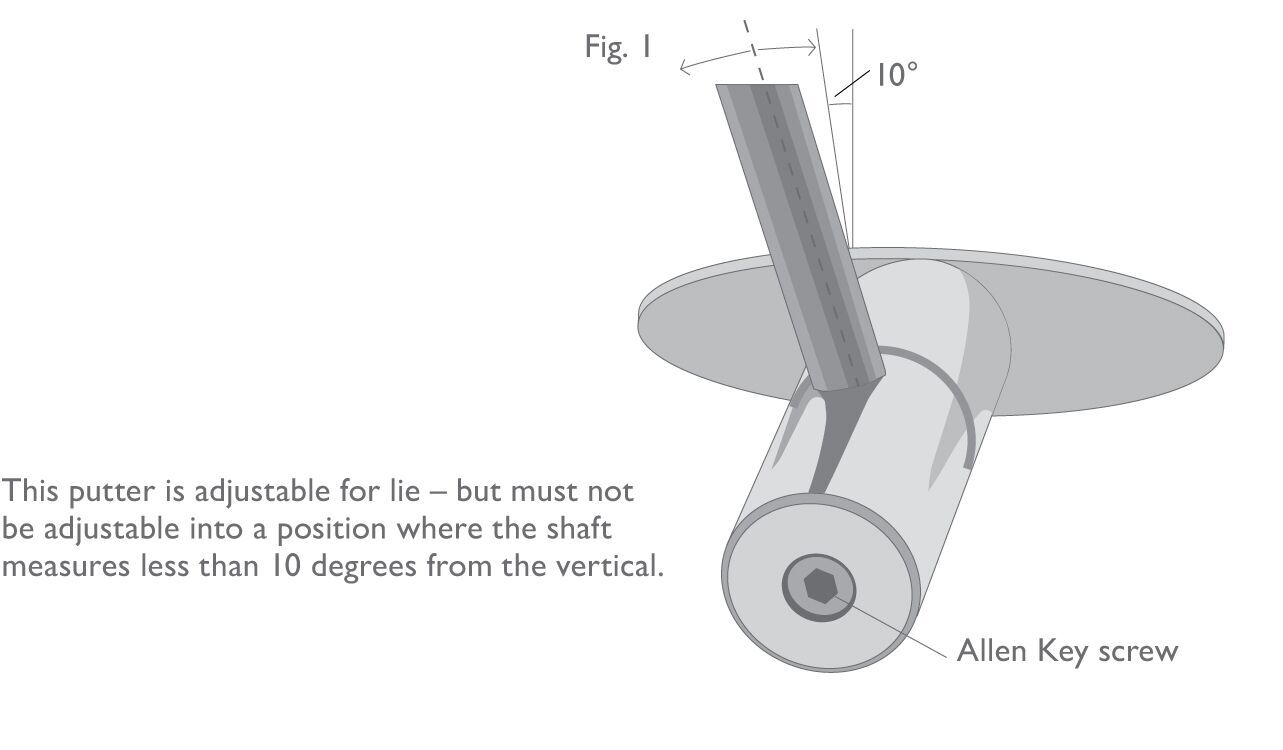
1.b(2) - Adjustability for Weight
All clubs may be designed to be adjustable for weight, provided the adjustment mechanism
conforms to the conditions described in Section 1b of the Equipment Rules. Examples
of what would and would not be permitted are illustrated in Figure 2.
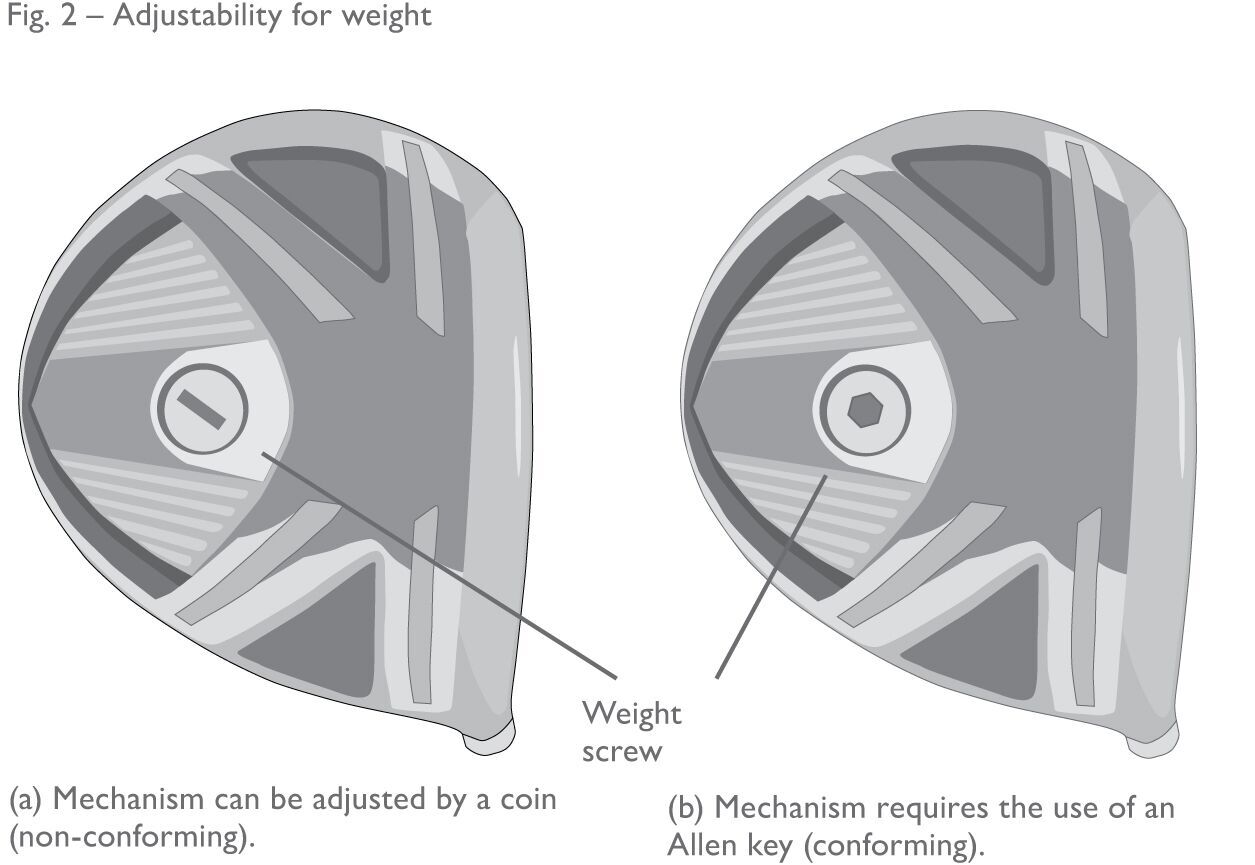
As noted in Section 1a, with respect to adjustments for weight, the only exception
to the conditions described in Section 1b(i) above is the addition or removal of lead
tape. This is a practice which pre-dates the introduction of the adjustability rules
and is permitted on ‘traditional’ grounds. The addition, removal or alteration of
lead tape during a round is not permitted (see Rule 4.1a(3) of the Rules of Golf).
1.b(3) - Adjustability for Length
• All Clubs
All clubs may be adjustable for length, provided the adjustment mechanism conforms
to the specifications already described and is consistent with other Equipment Rules.
Integrated mechanisms are permitted, provided the bending and twisting properties
of the shaft remain substantially the same and the grip remains conforming. Mechanisms
externally attached to the grip are not permitted.
Telescopic Mechanisms that can be fully extended into a locked position for use and
collapsed for travel purposes may be permitted. However, the club must not be usable
in its collapsed, unlocked state.
• Putters
Non-integrated mechanisms attached to the shaft may be permitted
for putters only, provided that:
-
The mechanism is generally circular in cross-section with a maximum cross-sectional
dimension of 1 inch and a maximum length of 2 inches;
-
If the mechanism is situated between two grips, both grips are non-tapered, the end
of the mechanism effectively touches the butt end of the lower grip, the cross-sectional
dimension of the mechanism is less than or equal to the maximum cross-sectional dimension
of the grips, and the mechanism is at least 1.5 inches in length;
-
If the mechanism is situated below a single grip or below the lower grip of a putter
with two grips, the top of the mechanism is at least 2 inches from the tip end of
the grip. Exception: If the size and shape of the mechanism is consistent with the
tip end of the grip or the outer diameter of the mechanism is less than the outer
diameter of the grip, the mechanism can effectively touch the tip end of the grip.
1.b(4) - Other Kinds of Adjustability
As previously noted, the adjustability provisions allow all clubs to be designed to
be adjustable for many different characteristics – provided all specifications are
satisfied. Manufacturers are encouraged, however, to submit all new adjustable design
innovations for evaluation in the early stages of development.
c. Length
Interpretation of Rule 1.c
This provision is straightforward and the measurement of woods and irons is well described
and illustrated above and in the official test protocol. The measurement of length
for putters is illustrated in Figure 4.
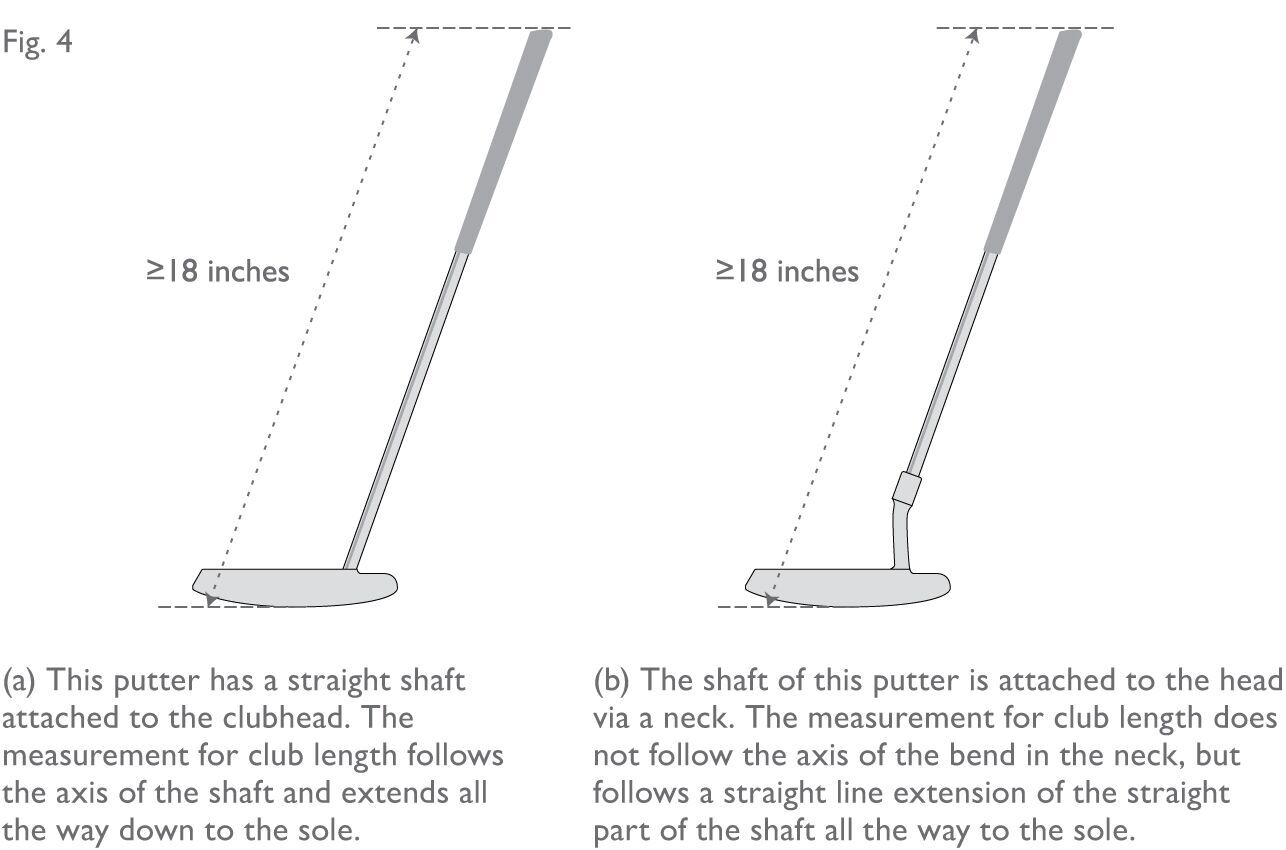
Local Committees may permit the use of clubs longer than the maximum length allowed,
provided that there is evidence of a medical or physical need for the player to use
such clubs and that the shortest club carried by the player is no more than 10 inches
shorter than his or her longest club, not including the putter.
The above provisions on club length mean that the concept of long and mid-length putters
still conform to the Equipment Rules. However, The R&A and USGA have adopted a position
that clubs designed for chipping, including modified wedges, that are longer than
standard length clubs of similar loft are not traditional and customary in form and
make (see Part 2, Section 1a).
The following table is used for the purpose of determining the maximum allowable length
of a chipping club.

d. Alignment
Interpretation of Rule 1.d
1.d(1) - Shaft Projection
Rule 1.d(i) and (ii) is particularly relevant to putters and it exists mainly as a
means for disallowing croquet style putters (with vertical shafts) and shuffle-board
style strokes (see Figure 7). It also seeks to limit the potential for more standard
putters from being used effectively in a vertical or near-vertical position using
a pendulum-style motion.
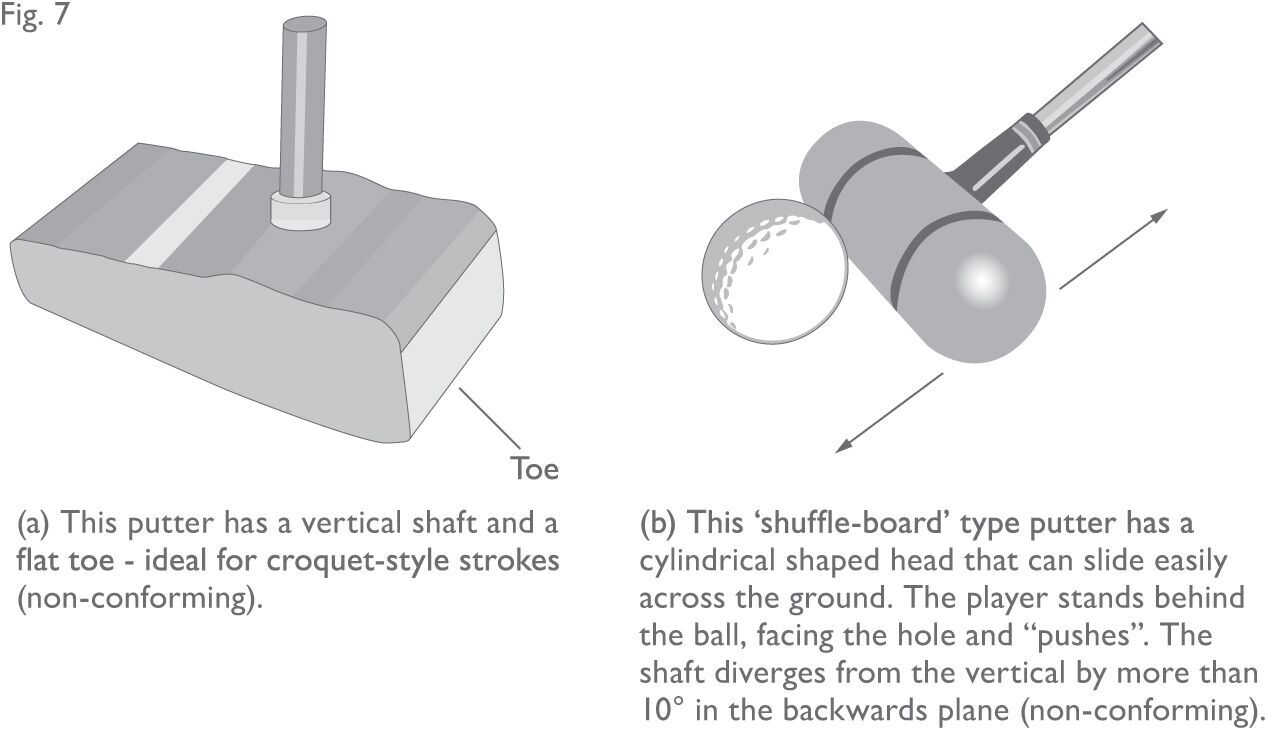
For most putters, the “normal address position” is determined by the geometry of the
head. The head would be placed on a horizontal flat surface, with the sole touching
that surface at a point directly below the centre of the face. The shaft angle would
then be measured with the head in this position (see Figure 8).
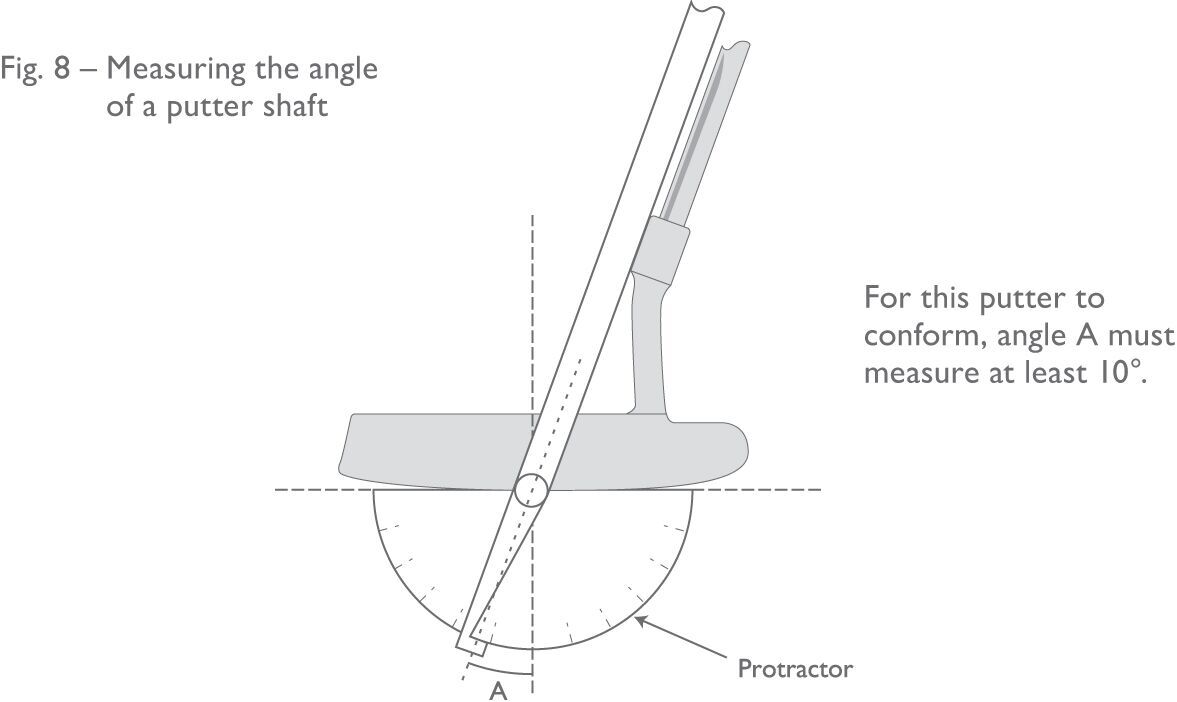
If the putter head shape or weight distribution is very asymmetric, it may be necessary
to make a subjective judgement as to where the effective centre of the face is and
then to sole the club directly below that point. The position of the head in this
instance might not always be the position that was intended when the club was designed,
but in some cases a judgement has to be made based on how the club could feasibly
and effectively be used (see Figure 9).
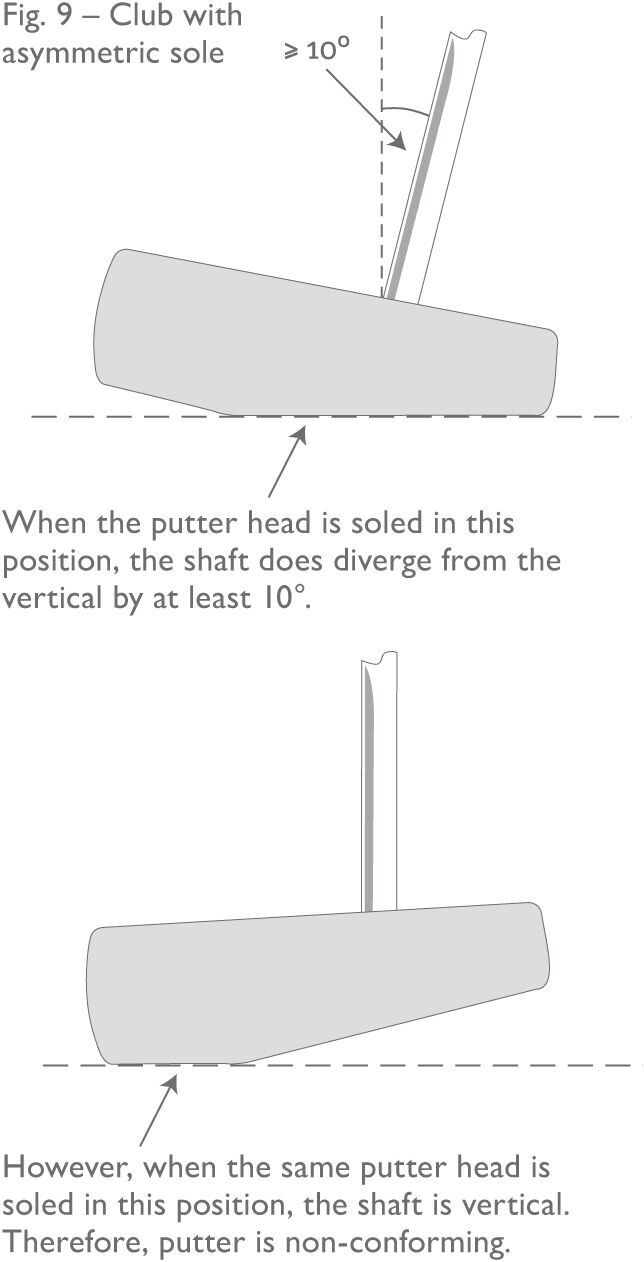
The same subjectivity may also be needed when confronted with a putter which has a
very curved sole (see Figure 10). As before, the conformance evaluation would take
into account not only the manner in which the putter is designed to be used, but also
the way it could feasibly and effectively be used, given the geometry of the head
as well as other unique characteristics of the overall design. This interpretation
is particularly relevant to long-shafted putters with very curved or multi-planed
soles – but standard length putters of 34-38 inches can also be subjected to this
assessment.
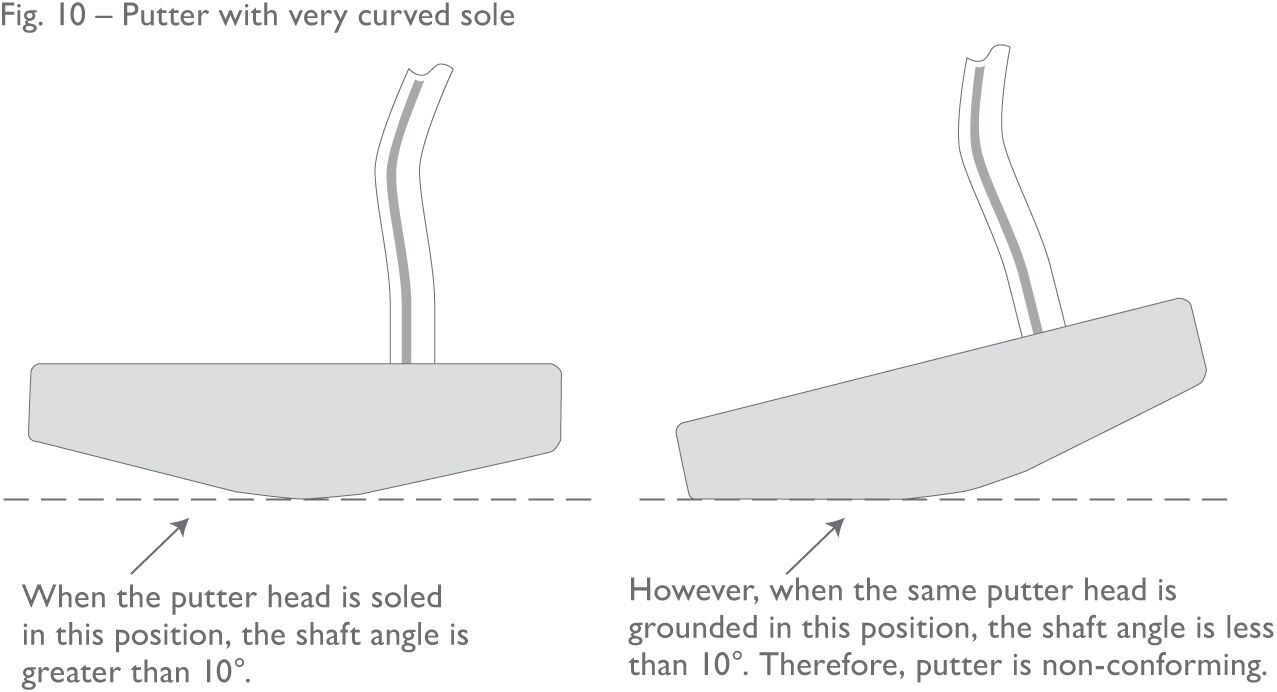
It should be noted that all putters can usually be positioned in such a way that the
shaft diverges from the vertical by less than 10° or even to a position where the
shaft itself is vertical. Also, it is unusual for the sole of a putter to be completely
flat all the way from heel to toe. When faced with a ruling of this kind, the decision
should not be based on whether a player uses the putter with the shaft in a position
less than 10° – but whether the putter design facilitates this (see Figure 11).
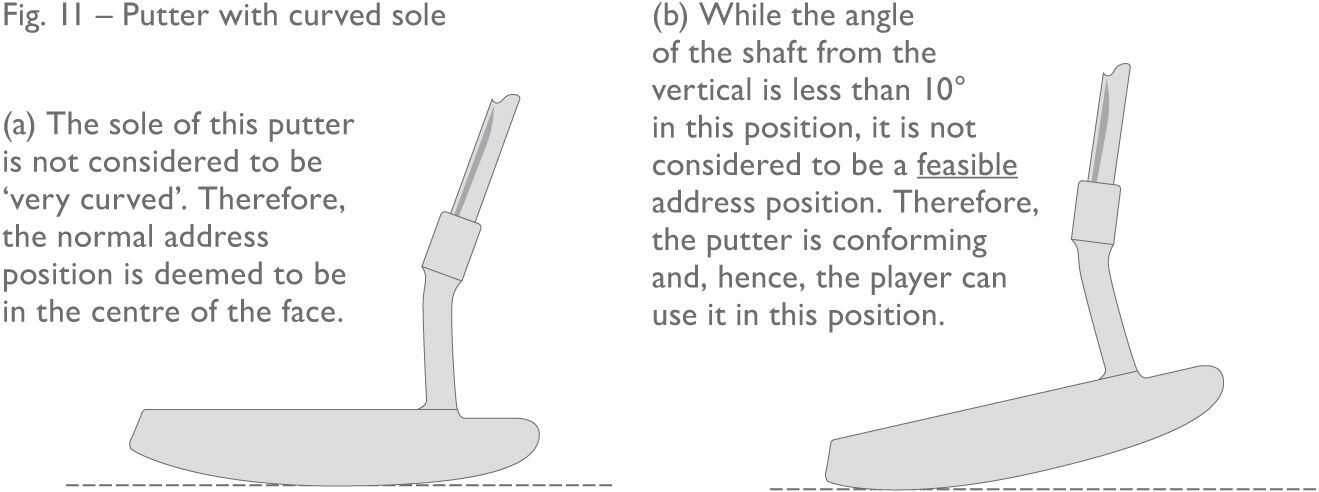
If the overall design of a putter is such that a player can putt effectively with
the shaft in a vertical or near-vertical position, it would be ruled contrary to Part
2, Section 1d, even if the shaft angle does satisfy the 10 degree Rule when the putter
is in its “normal address position”. The shaft angle on such a putter would be required
to be increased up to as much as 25 degrees. In assessing whether a putter can be
used effectively in such a position and in order to determine what the shaft angle
should be increased to, the combination of all of the following features must be considered:
-
length of shaft;
-
position of shaft attachment to head;
-
angle of shaft in toe to heel plane and front to back plane;
-
shape and weight distribution of head;
-
curvature and shape of sole; and
-
intent of the design.
This means that a long putter which has the shaft attached to the toe, a 10 degree
lie angle in the toe to heel plane and a curved sole could potentially be ruled non-conforming.
Even though each of these features, when taken in isolation, might conform to the
Equipment Rules, it is the combination of these features which could lead to a non-conforming
decision.
This is a good example of an area where rules officials should take care not to make
decisions unless they are completely certain that it is correct. If, after examining
the club and carrying out all of the appropriate consultations, it is still not possible
to give a definitive ruling, a Duration of Competition or Duration of Round Answer
should be given (see Supplementary Paper A – Advice to Rules Officials Concerning
Queries on the Conformity of Clubs at Competitions).
The determination of a putter’s “normal address position” or whether it can be used
in a vertical or close-to-vertical position can be highly subjective and in terms
of those putters which are actually submitted to The R&A or USGA, the job of making
rulings on them is only made easier because it is possible to compare them with previous
submissions and rulings.
1.d(2) - Heel Projection
The intent of the last provision in Rule 1.d is to prevent centre shafted clubs (see
Section 2c below – “Attachment to the Clubhead”), and the measurement of an iron club
is illustrated in Figure 13.
It is worth highlighting that the heel portion of the club extends from the face all
the way to the back of the head. Therefore, for unusually shaped heads (e.g. flared
or square shaped), where the outermost part of the heel may be further back from the
face than for more traditionally shaped heads, the measurement will be completed at
that point.
It is also worth stressing that, in most cases, the shaft of a putter may be attached
at any point on the clubhead (see Section 2c).
